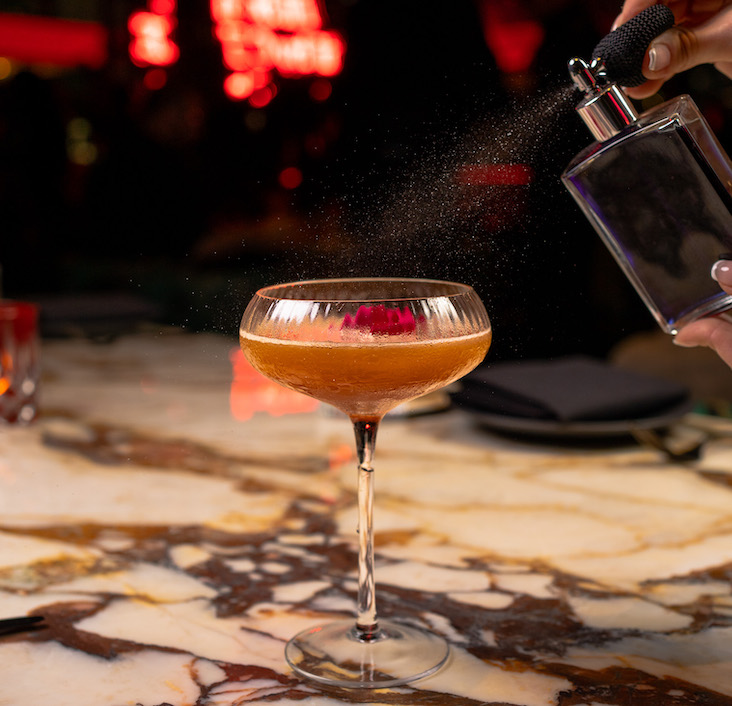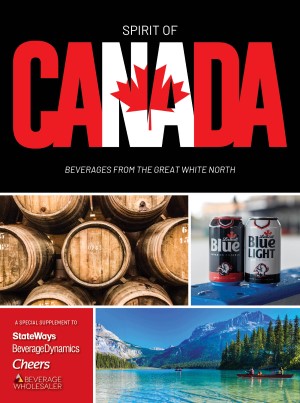WATER, WATER
everywhere
Bottled water sales are way up and are clearly profitable. Are you missing the boat?
by Peg Wallace
photography by
Paul Hilldebrand
Not so long ago, bottled water was an afterthought in the American consumer’s mind. Not anymore. Take a quick look around any city street or suburban mall, and you’ll find plastic water bottles competing with logo-emblazoned paper coffee cups as the most common accessory. In fact, bottled water has leveraged its place in the market to become one of the hottest selling beverages today, delivering healthy profits at minimal cost and offering substantial opportunities for the bar and restaurant operator.
Take a look at the numbers. For the third year in a row, industry growth has picked up momentum, with revenues reaching almost $4 billion. But the real story is in volume, as competitive pricing kept dollar growth lower than unit sales. Bottled water in fact is outgrowing the rest of the beverage industry; zooming from $1.1 billion in 1984 to over $3.9 billion in 1997.
Consider this: in 1997 fruit beverage sales grew 2.5%, beer 0.8% and soft drinks 3.3%. Bottled water sales grew more than all these others combined, coming in at a 9.6% increase.
Several factors may be contributing to this boom; America’s passion for fitness, the maturation of baby boomers, an increase in health-conscious attitudes and the perceived deteriorating quality of tap water. But there’s more. Bottled water has become a component of the complete dining experience and offers a bit of prestige in a brand- and status-conscious society.
Water Wings
It’s a segment that just keeps soaring–but how do successful operators build up the on-premise business?
At Patina in Los Angeles, available bottled waters are part of the award-winning wine list. It’s an indication of the belief of Christine Splichal, co-owner with husband/chef Joachim, that bottled water deserves to be treated like wine. “The waters have different properties, and there are different types of water,” she says. “Customers deserve to know that you are offering them something that is not just an alternative to tap water but has specific qualities. And many customers with discerning tastes expect that from a quality establishment.”
Not only should bottled water be treated better, but it can also be presented with a little of the flair that wines and other beverages merit. Henry Flutie, owner of Magnolia’s of Greenwich, Greenwich, CT, serves bottled water in silver buckets, creating a festive air for customers who order the water.
“We not only offer customers the option of bottled water, we offer them several different waters to choose from. The water is then served with ice and lemon or lime,” he says. “Water is becoming more of a delicacy these days. The way we treat water is very similar to how we treat a bottle of wine, as is the way we serve it.”
A little humor helps, too. “We ask the table if they want bottled water,” laughs Flutie. “Or if they prefer, we could serve Chateau Greenwich.”
“Remember,” he adds, “bottled water is like show business. People tend to want to be seen, and they enjoy using bottled water as a status symbol.”
Not only is it important to stock a variety of bottled waters, but understanding the qualities possessed by each brand is important. Only then can you find a water that complements your establishment.
Brand Fluidity
Elizabeth Takeuchi, the bar manager at Rubicon in San Francisco, decided she’d serve only Santa Lucia to her customers. “Ever since the first drought years ago, restaurants really got into the habit of serving tap water upon request only,” she observes. “This in itself created the opportunity for the server to suggest a bottle of water for the table. But taking that one step further, it’s important to find a brand or brands that reflect the restaurant and what you want your water to offer. We serve Santa Lucia because we feel that it is a subtle enough sparkling water to complement the food we serve. And we based our decision on the water’s taste.”
It’s important that the wait staff truly understands the qualities of the waters available, so they are able to articulate them to the customers. This is especially vital if the brands being sold are lesser known. Most people are familiar with such big sellers as Evian among still waters and Perrier and Pellegrino among the sparkling waters. If the server can relate an unfamiliar brand’s similarity to a mainstream brand such as these, then the customer is more likely to order an unexpected brand of bottled water rather than opting for tap water.
“It’s also important to price the water according to how you want it to reflect on your establishment and your bottom line,” advises Takeuchi. “We have our large bottle priced at $5.50 because we don’t want to have it at such a price point that when the customer gets the bill, they see they’ve spent $50 on water alone. We want the water to be reasonably priced so that it is an item that the customer does not deem a luxury but more a necessary part of the dining experience.”
Sell The Fizzy
Toney Edwards, owner of Le Madeleine in Manhattan, concurs. He reports an estimated 50% to 60% increase in bottled water sales as a result of two techniques: simply asking customers if they would like bottled water for the table and employing the water as a perk. “Bottled water should be a necessity in a positive dining experience. If customers don’t come in with that in mind, you need to find a way to show them just how enjoyable it is.”
The selling process starts when the customer first sits down. “Our serving staff is trained to ask the customer if they want bottled water or tap, and if bottled water is requested, they are asked if they want flat or sparkling,” Edwards explains. “On holidays, we will put a complimentary bottle of water on every table. This is a great way to introduce the water to customers who ordinarily would be hesitant to order bottled water. It also helps build the restaurant’s image with the customer, fosters customer loyalty and helps repeat sales. The cost is minimal, and you reap rewards on so many different levels.”
Le Madeleine’s regular customers receive complimentary bottles on a continual basis. “It’s a small way to show them their patronage is appreciated,” says Edwards, “and the bottled water becomes a necessity for them. They won’t hesitate to purchase several bottles for their meal. People become accustomed to having bottled water on the table. If it’s free the first few times, it’s less of a challenge to get them to order it again because they consider it part of the whole dining experience.”
Water Carriers
Managing water sales is simple, according to Michael Neuwirth, corporate communications director for Evian. “Stock it and ask if customers want it,” he says. “It’s a no-lose situation. You are already doing the activity of pouring and serving water to your tables, why not make a profit while doing it?” He points out that asking if customers want an item applies for every other menu option in the dining experience, so approaching water the same way should be easy.
Bottled water is an untapped well of profits, say operators and water representatives. It’s generally agreed that there are two major ways to grow profitability in the restaurant business: increase traffic and check averages. Offering more and better bottled water creates an opportunity to increase the check average.
“Bottled water offers an opportunity to deliver a single serving product at a 15% food cost, thereby delivering an 85% profit,” reports Jim Crystal, director of foodservice for The Perrier Group. “The activity of the wait staff is the same–they are serving water either way. Tap water is a loss because there is activity with cost to the restaurant. Bottled water is the same activity level with incredible profit.”
Another advantage is that people can alternate between alcohol-based drinks and bottled water. Mineralized and sparkling waters make excellent natural mixers with some beverages, and heightened awareness of alcohol consumption creates an opportunity for serving a beverage that doesn’t clash in taste with the customer’s cocktail of choice, but rather, complements it.
Bottled water also is considered a stylish beverage for alcohol abstainers. Some customers may feel self-conscious ordering a soft drink while every else at the table is ordering cocktails. Asking for a Perrier or Solé appears more sophisticated beverage choice than asking for, say, a root beer.
The bottled water industry just keeps growing, as does the customer’s thirst for it. Whether you choose to offer a portfolio of bottled waters or simply stock one still and one sparkling, bottled water is a liquid asset no restaurant can do without.
Peg Wallace is a San Francisco-based writer specializing in the hospitality industry.
NOT ALL WATER IS CREATED EQUAL
Still and sparkling, spring and distilled; as with other beverage categories, the water segment has its own terminology. Here are the different types of water available, with definitions set by the Federal Drug Administration.
Bottled Water
Water that is intended for human consumption and that is sealed in bottles or other containers with no added ingredients except that it may optionally contain safe and suitable antimicrobial agents. Fluoride may be optionally added. Bottled water may be used as an ingredient in beverages (e.g. diluted juices, flavored bottled waters).
Artesian Water
Water from a well tapping a confined aquifer in which the water level stands at some height above the top of the aquifer.
Ground Water
Water from a subsurface saturated zone that is under a pressure equal to or greater than atmospheric pressure.
Mineral Water
Water containing not less than 250 parts per million (ppm) total dissolved solids (TDS), coming from a source tapped at one or more bore holes or springs, originating from a geologically and physically protected underground water source. Mineral water shall be distinguished from other types of water by its constant level and relative proportions of minerals and trace elements at the point of emergence from the source, due account being taken of the cycles of natural fluctuations. No minerals may be added to this water.
Purified Water
Water that has been produced by distillation, deionization, reverse osmosis or other suitable processes.
Sparkling Water
Water that, after treatment and possible replacement of carbon dioxide, contains the same amount of carbon dioxide that it had at emergence from the source.
Spring Water
Water derived from an underground formation from which water flows naturally to the surface of the earth.
Sterile Water
Water that meets the requirements under “sterility tests” in the United States Pharmacopeia.
Well Water
Water from a hole bored, drilled, or otherwise constructed in the ground that taps the water of an aquifer.
NOT DEFINED: alpine, glacier, mountain, natural, 100%, organic, pure.




